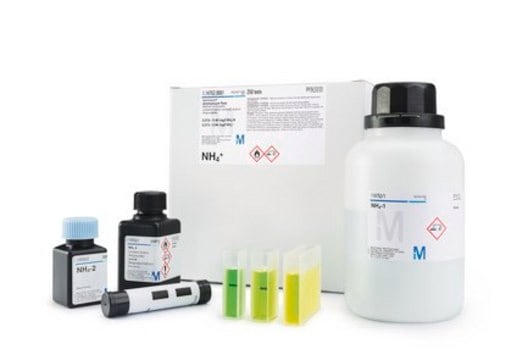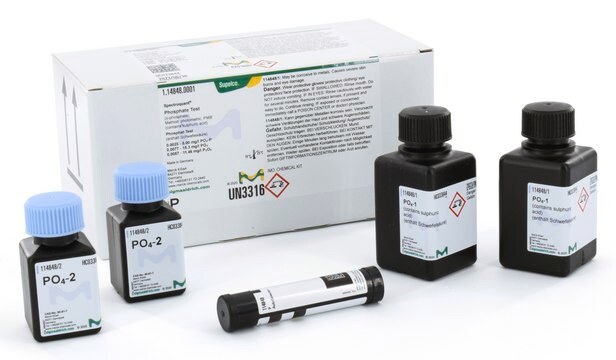MAK030
Phosphate Colorimetric Kit
sufficient for 500 colorimetric tests
Sign Into View Organizational & Contract Pricing
All Photos(2)
About This Item
UNSPSC Code:
12161503
NACRES:
NA.84
Recommended Products
usage
sufficient for 500 colorimetric tests
application(s)
cosmetics
environmental
food and beverages
detection method
colorimetric
storage temp.
room temp
General description
Phosphate is an essential component in living organisms and contributes to a variety of biological functions, including structural roles within nucleic acids, cellular membranes and bone. Phosphate is also important in the transport of cellular energy, nucleic acid metabolism and signal transduction. Hyperphosphatemia, a condition of excess phosphate levels in the blood, can lead to calcification of organs and interference with usage of other inorganic ions, such as iron, calcium, magnesium and zinc.
Phosphate is an essential component in living organisms and contributes to a variety of biological functions, including structural roles within nucleic acids, cellular membranes, and bone. Phosphate is also important in the transport of cellular energy, nucleic acid metabolism, and signal transduction. Hyperphosphatemia, a condition of excess phosphate levels in the blood, can lead to calcification of organs and interference with usage of other inorganic ions, such as iron, calcium, magnesium, and zinc.
The Phosphate Colorimetric Assay Kit provides a simple and direct procedure for measuring phosphate in a variety of samples. Phosphate reacts with a chromogenic complex, which results in a colorimetric (650 nm) product proportional to the amount of phosphate present. Phosphate concentrations between 1 μM and 1 mM, with a lower limit of detection of 0.1 nmol, can be directly determined.
The Phosphate Colorimetric Assay Kit provides a simple and direct procedure for measuring phosphate in a variety of samples. Phosphate reacts with a chromogenic complex, which results in a colorimetric (650 nm) product proportional to the amount of phosphate present. Phosphate concentrations between 1 μM and 1 mM, with a lower limit of detection of 0.1 nmol, can be directly determined.
Application
Phosphate colorimetric kit has been used to measure the phosphate concentration in a variety of samples.
Suitability
Suitable for measuring phosphate levels in a variety of samples including serum and urine
Principle
The Phosphate Colorimetric Assay Kit provides a simple and direct procedure for measuring phosphate in a variety of samples. Phosphate reacts with a chromogenic complex, which results in a colorimetric (650 nm) product proportional to the amount of phosphate present. Phosphate concentrations between 1 μM and 1 mM, with a lower limit of detection of 0.1 nmol, can be directly determined.
replaced by
Product No.
Description
Pricing
Signal Word
Warning
Hazard Statements
Precautionary Statements
Hazard Classifications
Aquatic Chronic 3 - Eye Irrit. 2 - Met. Corr. 1 - Skin Irrit. 2
Storage Class Code
8A - Combustible corrosive hazardous materials
Choose from one of the most recent versions:
Certificates of Analysis (COA)
Lot/Batch Number
Don't see the Right Version?
If you require a particular version, you can look up a specific certificate by the Lot or Batch number.
Already Own This Product?
Find documentation for the products that you have recently purchased in the Document Library.
Customers Also Viewed
Neurological heterotopic ossification following spinal cord injury is triggered by macrophage?mediated inflammation in muscle.
Genet F, et al.
The Journal of Pathology, 236(2), 229-240 (2015)
Pooja Bhardwaj et al.
Antimicrobial agents and chemotherapy, 62(1) (2017-10-19)
Vancomycin-resistant Enterococcus faecium strains (VREfm) are critical public health concerns because they are among the leading causes of hospital-acquired bloodstream infections. Chlorhexidine (CHX) is a bisbiguanide cationic antiseptic that is routinely used for patient bathing and other infection control practices.
Fluid, Electrolyte and Acid-Base Disorders (2014)
Reduced chlorhexidine and daptomycin susceptibility in vancomycin-resistant Enterococcus faecium after serial chlorhexidine exposure.
Bhardwaj P, et al.
Antimicrobial Agents and Chemotherapy (2017)
Advanced Biology for you. (2000)
Our team of scientists has experience in all areas of research including Life Science, Material Science, Chemical Synthesis, Chromatography, Analytical and many others.
Contact Technical Service




